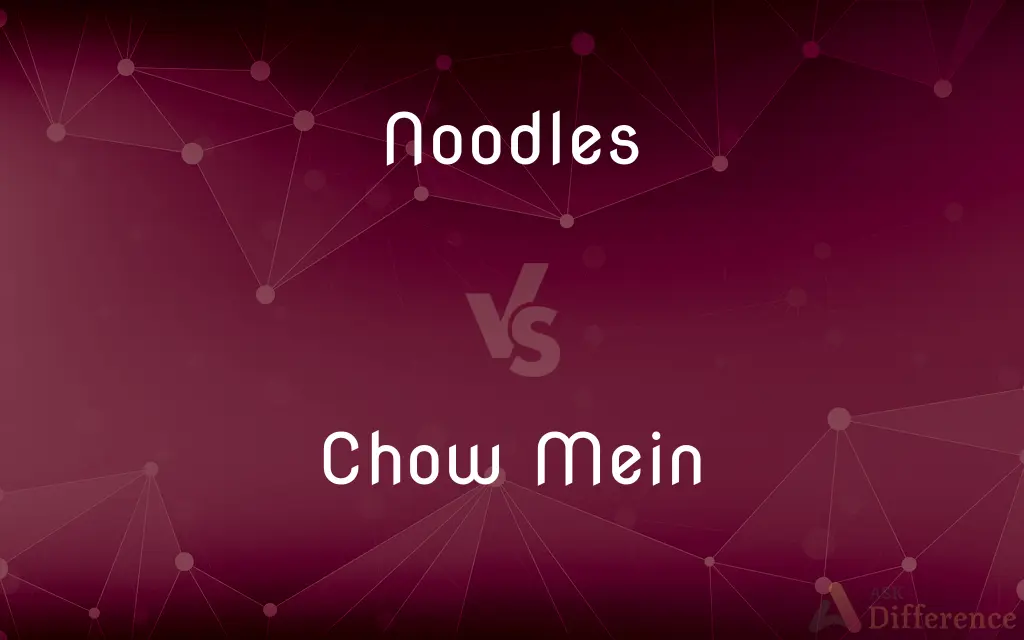Noodles vs. Chow Mein — What's the Difference?
By Tayyaba Rehman & Maham Liaqat — Published on September 16, 2024
Noodles are a broad category of food made from unleavened dough, while Chow Mein refers specifically to a Chinese dish made from stir-fried noodles with vegetables and sometimes meat.

Difference Between Noodles and Chow Mein
Table of Contents
ADVERTISEMENT
Key Differences
Noodles encompass a wide variety of shapes, sizes, and ingredients across different cultures, ranging from wheat and rice to egg-based varieties. Chow Mein, on the other hand, is a specific type of noodle dish that originates from Chinese cuisine, characterized by its preparation method and distinctive flavor.
Noodles serve as a base ingredient in numerous dishes worldwide, whereas Chow Mein is a complete dish that combines noodles with other ingredients such as vegetables, chicken, beef, or seafood, and is seasoned with soy sauce and other spices. This distinction highlights how noodles can be versatile, whereas Chow Mein is a specific culinary creation.
The preparation of noodles can vary widely, from boiling to frying, and they can be served in soups, salads, or as a main course. Chow Mein specifically refers to noodles that are parboiled and then stir-fried until they have a slightly crispy texture, which is a key aspect of the dish.
Noodles can be made from different types of flour, including wheat, rice, and buckwheat, leading to variations in texture and taste. Chow Mein noodles are traditionally made from wheat flour, which gives them a chewy texture that's ideal for stir-frying.
The cultural significance of noodles spans across many countries, reflecting a diverse range of culinary traditions and preferences. Chow Mein, as a dish, represents a specific facet of Chinese cuisine, offering insight into the flavors and cooking techniques favored in China.
ADVERTISEMENT
Comparison Chart
Origin
Global
Chinese cuisine
Ingredients
Wheat, rice, egg, etc.
Wheat flour noodles, vegetables, meat/seafood
Preparation
Boiled, fried, etc.
Parboiled, then stir-fried
Texture
Varies (soft to firm)
Chewy and slightly crispy
Serving
In soups, salads, main courses
As a complete main dish with added ingredients
Compare with Definitions
Noodles
Noodles are a staple food made from unleavened dough, cut into various shapes.
Spaghetti is a popular type of noodle in Italian cuisine.
Chow Mein
It's a staple in Chinese cuisine and has variations across regions.
Hong Kong-style Chow Mein features noodles fried until crispy before being topped with a thick sauce.
Noodles
They can be a main dish, side dish, or part of soups and salads.
Egg noodles are frequently used in American casseroles.
Chow Mein
It typically uses wheat flour noodles for a chewy texture.
Vegetable Chow Mein showcases stir-fried noodles with mixed vegetables.
Noodles
They can be made from different types of flour, including wheat, rice, and eggs.
Udon noodles are thick, wheat-flour noodles in Japanese cuisine.
Chow Mein
Chow Mein is often garnished with onions, beansprouts, and other vegetables.
Shrimp Chow Mein combines seafood with traditional Chinese flavors.
Noodles
Noodles are versatile and can be served in numerous ways.
Rice noodles are often used in Vietnamese pho.
Chow Mein
Chow Mein is a Chinese stir-fried noodle dish with vegetables and sometimes meat.
Chicken Chow Mein is a popular takeout choice.
Noodles
The texture and flavor of noodles vary based on their ingredients and preparation.
Buckwheat noodles have a distinctive taste and are used in Korean and Japanese dishes.
Chow Mein
The dish is known for its slightly crispy noodles and savory sauce.
Beef Chow Mein includes thinly sliced beef with a soy sauce-based seasoning.
Noodles
A narrow, ribbonlike strip of dough, usually made of flour, eggs, and water.
Noodles
To catch or try to catch a fish, usually a catfish, by hand, characteristically by allowing the fish to bite one's hand or placing one's hand in the fish's mouth, and then grabbing the fish by the mouth or through the gills.
Common Curiosities
Can noodles be used in cold dishes?
Yes, noodles can be served cold in dishes like salads and cold noodle bowls.
Is Chow Mein always made with meat?
No, Chow Mein can be vegetarian, containing only noodles, vegetables, and sauce.
Are all noodles suitable for stir-frying like in Chow Mein?
Not all noodles have the right texture for stir-frying; some are better suited for boiling or serving in soups.
What are noodles made of?
Noodles can be made from wheat, rice, buckwheat, or egg, among other ingredients.
What distinguishes Chow Mein from Lo Mein?
The main difference is in the preparation; Chow Mein noodles are stir-fried to a crisp, while Lo Mein noodles are fully boiled and then mixed with sauce.
Can gluten-free noodles be used to make Chow Mein?
Yes, gluten-free alternatives like rice noodles can be used, though the texture will differ from traditional wheat noodles.
How do you properly cook noodles for Chow Mein?
For Chow Mein, noodles are parboiled until just tender, then stir-fried until they start to crisp.
Is there a difference between homemade and restaurant-style Chow Mein?
Restaurant-style Chow Mein might have a more intense flavor due to higher heat and specialized equipment.
Can Chow Mein be made spicy?
Yes, spices or hot sauce can be added to adjust the heat level.
Are noodles considered healthy?
Noodles can be part of a balanced diet, but their healthiness depends on the ingredients and preparation method.
Is Chow Mein considered fast food?
It can be, especially in Western countries where it's a popular takeout option.
What's the best way to store leftover Chow Mein?
Leftover Chow Mein should be refrigerated in an airtight container and consumed within 2 days for best quality.
What are some common vegetables used in Chow Mein?
Common vegetables include cabbage, carrots, onions, and beansprouts.
Can rice noodles be used in Chow Mein?
While not traditional, rice noodles can be used for a different texture and flavor.
Are there regional variations of Chow Mein within China?
Yes, Chow Mein can vary significantly in ingredients and preparation methods across different regions of China.
Share Your Discovery

Previous Comparison
Urologist vs. Nephrologist
Next Comparison
Mega Man vs. Mega Man XAuthor Spotlight
Written by
Tayyaba RehmanTayyaba Rehman is a distinguished writer, currently serving as a primary contributor to askdifference.com. As a researcher in semantics and etymology, Tayyaba's passion for the complexity of languages and their distinctions has found a perfect home on the platform. Tayyaba delves into the intricacies of language, distinguishing between commonly confused words and phrases, thereby providing clarity for readers worldwide.
Co-written by
Maham Liaqat












































